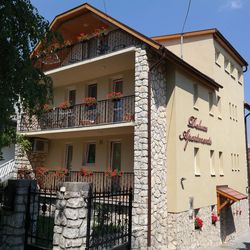Where happy goats give you cheese, yogurt, and kefir
At her small-batch workshop in Cserszegtomaj, Emese Tusz handcrafts cheeses and dairy products without additives, using milk from goats raised on her family farm. What began as a solution to her son’s dietary needs has grown into a beloved craft, allowing many others to enjoy high-quality dairy products again.
If you’re looking for clean, pure, and lactose-sensitive-friendly delights — start your tasting journey here. A former German teacher, Emese started experimenting with goat’s milk when her son was diagnosed with dairy protein and lactose intolerance. Her home experiments quickly turned into a passion, then a profession. She completed a two-year dairy processing course in Csermajor and established her own workshop in Cserszegtomaj.
Today, her son — who has grown up around goats — also takes part in the daily farm work.
For sensitive stomachs and gourmet palates
At Emese’s market stall, you’ll find fresh goat cheeses flavored with herbs, aged Jersey cow cheeses, yogurt, kefir, and occasionally butter and cottage cheese — all made with milk from her own farm. Her goat herd currently numbers around 80, with about three-quarters producing milk. All products are made with pasteurized milk, natural rennet, and selected cultures, ensuring a clean, mild flavor with no strong "goaty" taste.
Emese cares for her goats with expertise and attention, knowing that healthy, clean animals are key to quality cheese. She uses no additives, flavor enhancers, or preservatives. Each product is made by hand — from shaping the cheese to seasoning it. Emese adapts her recipes daily, responding to the natural variations in milk:
“Every day, the milk behaves differently. Its taste, texture, everything changes — you can’t force it into a formula, you have to follow its lead.”
Fresh cheeses are often seasoned with smoked paprika or herbs. The yogurt is thick yet silky, while the kefir is light but full-flavored. Aged cheeses offer a deeper, more complex taste profile. Emese also keeps a Jersey cow, whose A2 beta-casein-rich milk broadens her product range — perfect for sensitive customers. Her aged cheeses and limited-edition yogurts often come from this milk, crafted with separate recipes to suit its unique character.
Seasonal production
Goats naturally begin producing milk after spring births, with milking season typically lasting through autumn. As a result, fresh goat milk products — like cheese, yogurt, and kefir — are only available during certain times of the year. In winter, when the goats rest, production pauses.
Only at the market — Always personal
You can find Emese’s products exclusively at the Hévíz Farmers’ Market. For her, meeting customers is part of the experience. She loves to talk about her cheeses, her goats, and how everything is made — often sharing pairing tips as well.
“If it’s good enough for my son, it’s good enough for anyone.”
This simple philosophy sums up what makes Emese’s products so special: they are healthy, natural, delicious — and crafted with honesty, heart, and care.
Product highlights
Goat cheeses in a variety of flavors
Fresh cheeses, creamy spreads, yogurt, and kefir — all made from milk sourced from Emese’s own goats, crafted with over a decade of experience. Every product is made with pasteurized goat’s milk, natural rennet, and carefully selected cultures. Fresh cheeses are prepared just before market days to guarantee freshness. In addition to plain, natural cheeses, you’ll find exciting flavors: garlic, chili, red onion, fenugreek, chives, and even a dessert cheese with walnuts and cranberries. Emese emphasizes quality and gluten-free safety, using Lukullusz ingredients to ensure her cheeses are safe for gluten-sensitive customers.
No additives, no colorings, no preservatives. Smoked varieties are cold-smoked over beechwood, preserving their soft texture and natural aromas. Goat cheese pairs perfectly with a slice of sourdough bread, tossed into a fresh salad, or served alongside crisp apples.
Where to buy
- Hévíz Farmers’ Market
More information & Contact:
- Phone: +36 30 709 3640
The Life-Giving Winds of the Ice Age: How Loess Shaped the Land Did you know that Transdanubia’s rich, golden soils are actually a gift from the winds of the Ice Age? Loess isn’t just a dry geological term — it’s an ancient natural recipe that gave rise to some of the most fertile soils in the Carpathian Basin. Where vineyards grow today and birds nest in loess cliffs, strong winds once carried yellow dust across the landscape — for thousands of years. Learn how this unique sediment shaped the land and why loess is still essential for sustainable farming today. What Is Loess and How Did It Form? The term loess comes from the German word lose, meaning "loose." Loess is a fine-grained, yellowish sediment that was deposited during the Pleistocene epoch (2.58–0.01 million years ago), particularly during glacial periods. It formed in periglacial environments south of the great Scandinavian ice sheet — cold, dry landscapes with little or no vegetation. The dust was carried by strong Ice Age winds from floodplains and barren steppes, and slowly accumulated over tens of thousands of years. Eventually, calcium carbonate cemented these layers into loess, which developed characteristic vertical fissures. It’s important to note that the Pleistocene wasn't a single “Ice Age,” but a period that included alternating cold and warm phases — some even warmer than today. Loess and the Landscape Loess gave the Carpathian Basin — especially Transdanubia — its distinct terrain. Steep loess cliffs (sometimes up to 10 meters high), caves that provide nesting sites for bee-eaters and sand martins, centuries-old sunken roads carved into hillsides, and exposed root systems are all part of the landscape’s geological legacy. Together, they define the unique character of this region — shaped by time, wind, and stone. Fertility and Water Retention Loess-rich areas have produced some of the most fertile soils in the region. Many local producers farm on land that sits atop loess. This creates an excellent foundation for agriculture — not just because of the high humus content, but also because loess has outstanding water-holding capacity. Its vertical pores allow moisture to penetrate deeply and remain in the soil, even during dry periods. A Modern Echo — Dust from the Sahara Interestingly, the fine Saharan dust that now reaches Central Europe more frequently can be seen as a modern counterpart to loess-forming material. It’s a reminder that the powerful natural forces that shaped the land long ago are still at work today — just on a different scale.















